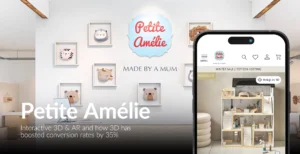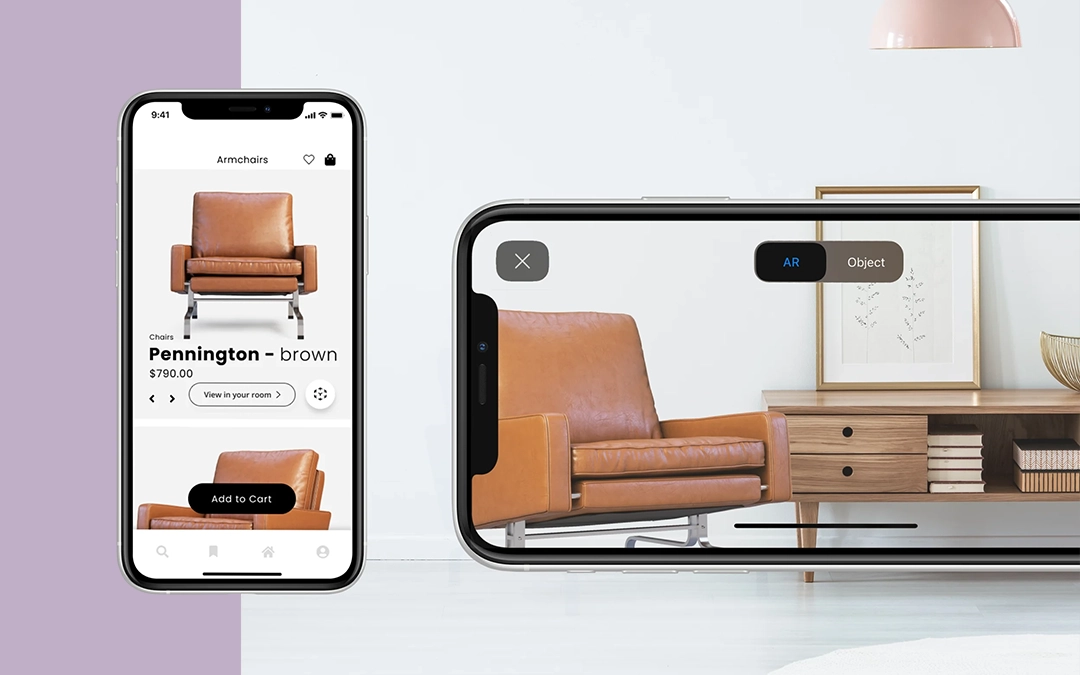In the competitive world of online furniture sales, achieving high conversion rates is challenging. With e-commerce conversion rates in the furniture sector averaging as low as 0.8%, compared to an average of 2.5% – 3% for all industries, finding effective strategies to enhance your online presence and sell more furniture online is essential. Here’s how to boost those numbers by implementing some highly effective visual content tactics:
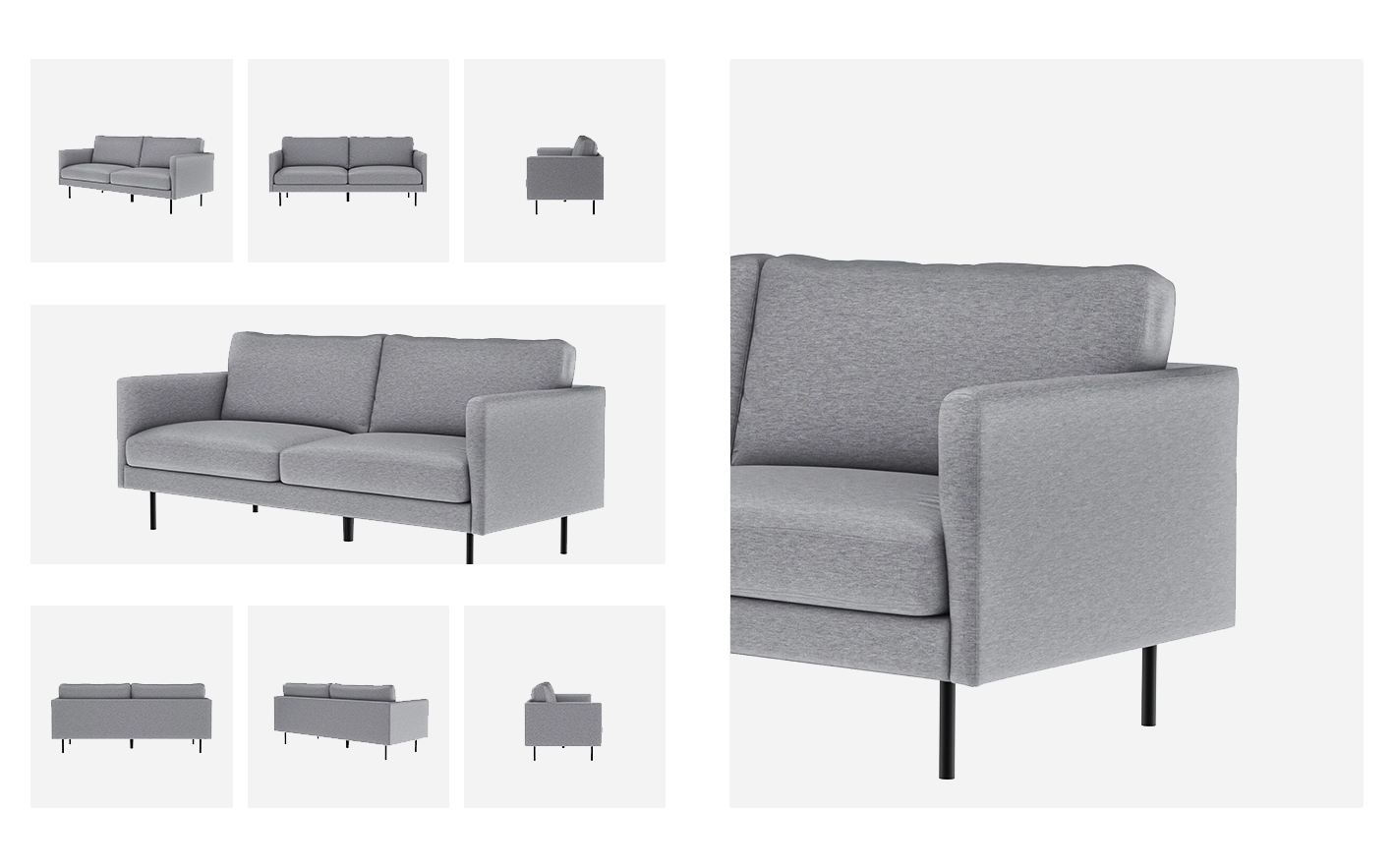
1. Invest in high-quality visual product content
High-quality product images are crucial for standing out from the competition and establishing a credible, professional brand image. Poor visuals can deter potential buyers, with 56% of online shoppers refusing to buy from websites with subpar product photos.
Using high-quality images greatly enhances your website’s overall user experience. Clear, detailed pictures help customers understand the product better, reducing uncertainty and increasing their confidence in purchasing. For example, showcasing a fabric sofa’s texture, color, and intricate details can substantially affect how potential buyers perceive the product’s quality and value.
Providing these high-resolution images reduces the likelihood of returns, as customers receive precisely what they expect based on the visuals presented. This boosts sales and fosters customer trust and loyalty, which are essential for long-term business success.
Also, high-quality visuals contribute to a polished and professional website appearance, reinforcing your brand’s reputation and credibility in the eyes of consumers. By consistently delivering visually appealing and accurate product images you create a reliable and enjoyable shopping experience that encourages repeat business and positive word-of-mouth referrals.
We highly recommend checking out Orbitvu’s range of automated product photography solutions, tailored specifically to the furniture.
Benefits of High-Quality Visuals
- Increased Credibility: Professional images enhance your brand’s perceived value, making it look trustworthy and reliable. For example, a high-resolution image of a beautifully designed sofa can instantly attract a potential buyer’s attention and interest.
- Higher Engagement: Attractive visuals encourage users to spend more time on your site. If your product images are visually appealing, customers are more likely to explore other products, leading to increased engagement.
- Improved Conversion Rates: Better visuals increase conversion rates and sales. A detailed and precise image of a dining table set, accurately showing the texture and color, can convince a customer to purchase.
2. Introduce 3D technology for higher product engagement.
Interactive shopping experiences are key to e-commerce success. 3D technology allows customers to rotate and zoom in on products, providing a comprehensive view of the quality and details. This engagement boosts informed purchasing decisions, resulting in higher conversion rates and fewer returns.
Implementing 3D technology can differentiate your brand in a crowded marketplace. As customers increasingly look for and expect immersive and interactive shopping experiences, offering 3D views can position your brand as an industry leader in innovation. This technology caters to various customer preferences, from those who want to inspect every detail closely to those who prefer a quick, comprehensive overview.
By accommodating these shopping behaviors, you enhance customer satisfaction and build a more versatile and appealing online store. Additionally, 3D technology can be particularly beneficial for complex or high-value items, such as modular furniture or custom pieces, where understanding the product’s intricacies can make a significant difference in the purchase decision.
Benefits of 3D Technology
- Enhanced Engagement: 3D viewers increase ‘add to cart’ rates by allowing customers to interact meaningfully with the product. For instance, a 3D view of a wardrobe lets users inspect it from every angle.
- Reduced Returns: Customers make more confident purchases, leading to fewer returns. When buyers can thoroughly examine a product virtually, they are less likely to be disappointed upon delivery.
- Better Understanding: Detailed views help customers appreciate the product’s features. This is particularly useful for complex items like modular furniture, where understanding the assembly and design is crucial.
Try Interactive 3D and AR for FREE!
Why not experience the power of interactive 3D and AR with your product? Totally free. Request your free model today
3. Utilize Product Videos and 360 Spins
Short product videos (10-15 seconds) and 360-degree spins significantly enhance product detail pages, social media, and marketing campaigns. These formats offer dynamic views and detailed insights into the products, making them more appealing and easier to understand.
Incorporating these dynamic visual elements can also improve your site’s SEO performance. Videos and interactive spins increase visitors’ time on your pages, signaling to search engines that your content is valuable and engaging. For instance, a quick video showcasing the functionality of a convertible sofa or a 360-degree spin of a dining table set can captivate potential buyers, encouraging them to explore further and stay longer on your site.
These engaging formats also perform well on social media platforms, where visual content is more likely to be shared and viewed, extending your reach and attracting a broader audience. Additionally, product videos and 360 spins can help bridge the gap between online and offline shopping experiences, providing customers with a comprehensive view of the product that mimics the in-store experience, thus building trust and increasing the likelihood of purchase.
Benefits of Product Videos and 360 Spins
- Detailed Insights: Videos and spins provide comprehensive product views. For example, a video showing how a recliner sofa operates can effectively demonstrate its functionality.
- Higher Engagement: Engaging formats keep customers interested. For instance, a 360-degree spin of a coffee table allows users to see it from all sides, increasing their interaction time.
- Boosted Conversions: Better product understanding leads to higher purchase rates. Customers who can see a bed frame from every angle and in different settings are likelier to add it to their cart.
4. Offer Augmented Reality (AR) for confident purchases
Augmented Reality (AR) allows customers to visualize products in their homes, enhancing their confidence in purchasing. According to a study by Snapchat, 92% of GenZ want to use AR for shopping, and 49% of millennials consider it ‘very important.’
AR can significantly reduce customers’ decision-making time. AR eliminates much guesswork in online shopping by allowing them to see how the furniture fits and looks in their actual space. For instance, a customer can use AR to place a virtual coffee table in their living room, checking for compatibility with existing decor and spatial constraints. This immediate visualization can lead to quicker, more confident purchasing decisions, reducing cart abandonment rates.
AR features can be a powerful differentiator for your brand, appealing to tech-savvy consumers who seek the most advanced shopping experiences. By integrating AR, you enhance customer satisfaction and engagement while positioning your brand at the forefront of technological innovation in e-commerce.
Benefits of AR
- Increased Engagement: AR makes shopping interactive and fun. For example, allowing customers to place a virtual sofa in their living room can increase their interest and engagement.
- Better Decision-Making: Customers can see how products fit into their space, reducing uncertainty and helping them make more informed decisions.
- Higher Satisfaction: AR leads to more confident and satisfied customers. When buyers can visualize how a dining set looks in their dining area, they are more likely to be pleased with their purchase.
Watch our webinar on effortless furniture content creation
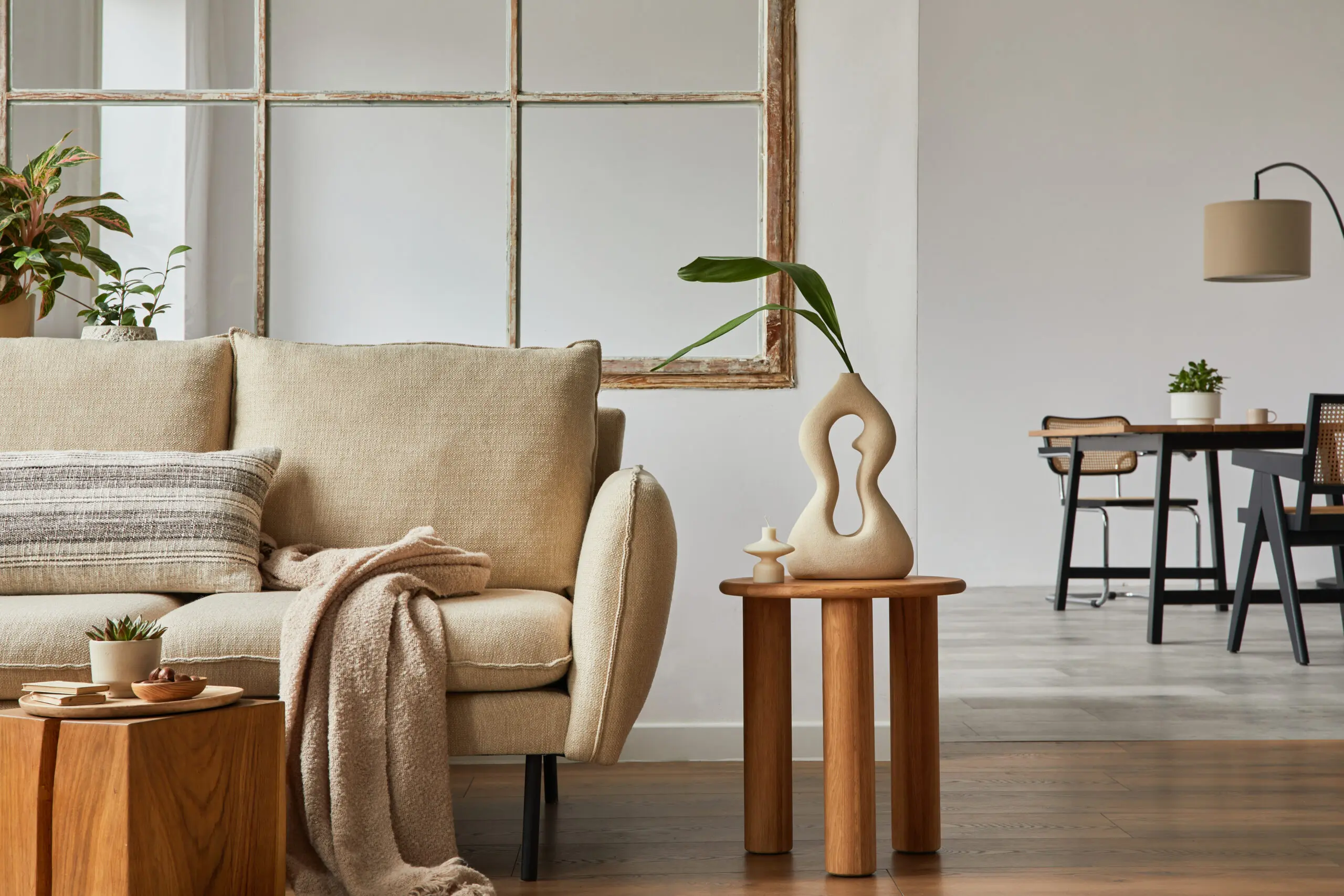
5. Showcase products in context
Displaying products in life-like settings helps customers envision how they will look in their homes. This contextual presentation boosts conversions by making it easier for shoppers to connect with the products.
Additionally, contextual images can create an emotional connection between the customer and the product. Seeing a dining table beautifully set in a cozy dining room or a stylish sofa in a modern living room setting allows customers to imagine these items as part of their lives. This emotional engagement can drive a stronger desire to purchase, as customers are not just seeing a product but envisioning a lifestyle.
On top of that, lifestyle renders can highlight the versatility and practicality of your products, showing them in various settings and uses. This can be particularly effective for multifunctional furniture or items that fit well in both small apartments and larger homes. By providing these immersive, relatable visuals, you make it easier for customers to understand how your products can enhance their living spaces, increasing their confidence and motivation to buy.
Benefits of Contextual Product Displays
- Improved Visualization: Customers see products in realistic settings. For example, showcasing a bedroom set in a well-decorated room setting helps customers imagine it in their home.
- Higher Conversions: Contextual images lead to better engagement and sales. A living room setup with a sofa, coffee table, and decor can make the products more appealing.
- Less studio time needed: Lifestyle renders effortlessly achieve this effect. You can create high-quality contextual images without needing a physical photo shoot, saving time and costs.
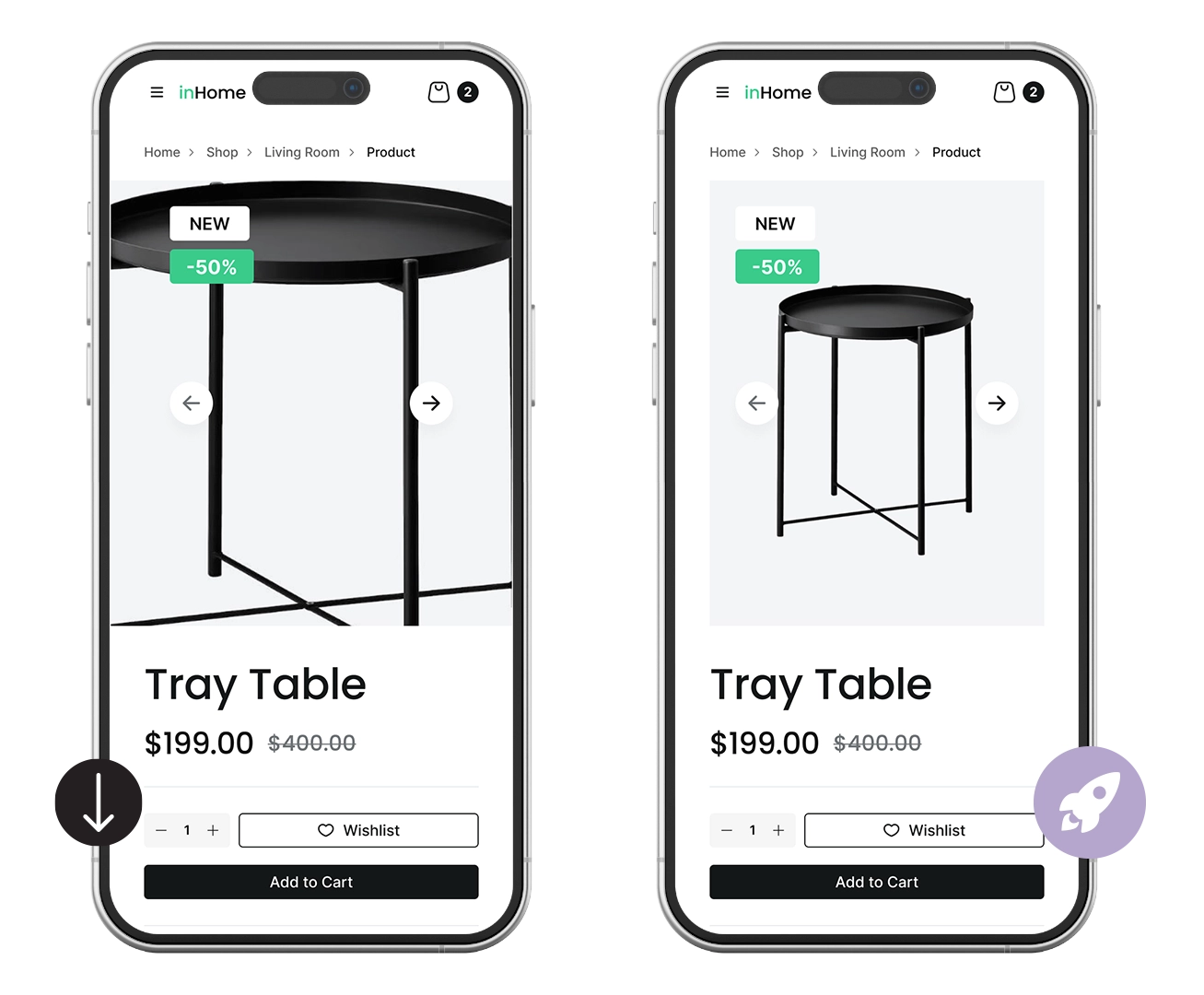
6. Optimize the mobile experience
Many e-commerce furniture retailers struggle with non-optimized mobile content, leading to issues like unscaled images and slow loading times. Optimizing the mobile version of your site ensures a smooth user experience, relevant information, and easy navigation, which are critical for boosting conversions.
With a significant portion of online shopping now taking place on mobile devices, a seamless mobile experience is no longer optional but essential. According to recent statistics, mobile commerce is expected to account for nearly 54% of total e-commerce sales. If your mobile site is slow or difficult to navigate, you risk losing many potential customers.
Ensuring product images are properly scaled and loaded quickly can prevent frustration and reduce bounce rates. Intuitive mobile navigation allows users to find what they’re looking for without hassle, increasing the likelihood of a purchase. Incorporating features like mobile-friendly payment options and easy access to customer support can further enhance the mobile shopping experience. Focusing on these aspects creates a more engaging and efficient mobile shopping environment, directly contributing to higher conversion rates and customer satisfaction.
Benefits of Mobile Optimization
- Enhanced User Experience: Smooth, easy-to-navigate mobile sites keep customers happy. A fast-loading mobile site with properly scaled images ensures customers can browse without frustration.
- Higher Conversion Rates: Mobile-optimized sites lead to more sales. Customers are more likely to complete purchases if the mobile shopping experience is seamless.
- Reduced Bounce Rates: Fast, responsive mobile sites prevent users from leaving. A mobile-friendly site that loads quickly keeps users engaged and reduces the likelihood of them abandoning their shopping.
7. Elevate Customer Experience with Product Configurators
Consumers expect personalized shopping experiences. Integrating a product configurator allows customers to visualize their choices, such as colors, materials, sizes, or finishes, before purchasing. This enhanced visualization meets customer expectations and encourages them to pay a premium price.
Offering a configurator can significantly enhance customer satisfaction and loyalty. When customers can see exactly how their chosen options will look on the final product, they are more likely to feel confident and satisfied with their purchase. For example, allowing customers to see a virtual representation of a sofa in their selected fabric and color helps them envision it in their living room, reducing uncertainty and the likelihood of returns.
Additionally, products that customers can configure themselves often carry a higher perceived value, which can justify a premium price. This approach increases your average order value and positions your brand as customer-centric and innovative. Leveraging advanced configurator tools on your e-commerce platform provides a seamless and enjoyable experience, further differentiating your brand in a competitive market.
Benefits of Personalization
- Increased Customer Satisfaction: Visualizing their options in real-time allows customers to see exactly how their product will look, reducing uncertainty and enhancing satisfaction. For example, seeing a virtual sofa in their selected fabric and color helps them feel confident about their choice.
- Higher Sales: Configurable products often carry a higher perceived value, leading to premium pricing and increased sales. Customers are willing to pay more when they can see and customize their product to fit their preferences.
- Enhanced Loyalty: Offering a personalized shopping experience through configurators builds stronger customer relationships. The ability to visualize and tailor products creates a loyal customer base that values the unique and tailored shopping experience.
What Can You Expect?
Focusing on high-quality visual content, interactive technologies, and personalized experiences can uplift conversions, reduce returns, and positively impact your brand image. These strategies will transform your e-commerce platform, creating an optimal shopping experience that boosts customer loyalty and increases average cart value.
These approaches can provide valuable insights into customer preferences and behaviors. By analyzing which products are frequently customized or viewed in 3D or AR, you can better understand what your customers are looking for. This data can inform future product development and marketing strategies, allowing you to tailor your offerings more precisely to meet customer demands.
A seamless and engaging shopping experience can encourage word-of-mouth referrals and positive reviews, expanding your customer base and enhancing your reputation. You can create a sustainable competitive advantage in the crowded e-commerce market by continuously innovating and focusing on what drives customer satisfaction.
In conclusion, implementing the above will lead to
- Uplift Conversions: Better visuals and interactive content lead to higher ‘add to cart’ rates and more sales. High-quality images, 3D views, and AR features make products more appealing, encouraging purchases.
- Lower Returns: Detailed product information helps customers make informed decisions, reducing the likelihood of returns. Customers who clearly understand what they are buying are less likely to be dissatisfied.
- Impact Brand Image: High-quality visual content enhances your brand’s reputation and distinguishes you from competitors. Innovative visual content showcases your brand as modern and customer-focused.
- Optimal Experience: To enhance customer loyalty and satisfaction, focus on selling experiences rather than just products. An engaging, personalized shopping experience creates a positive impression and encourages repeat business.

Martijn van Weede
Client Success Director
